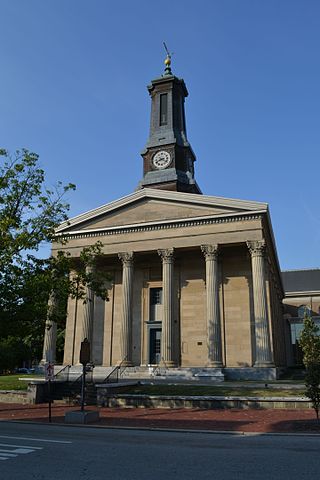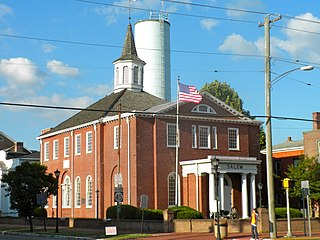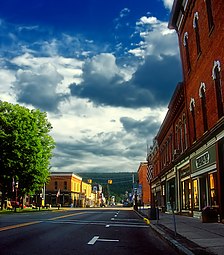
Coudersport is a borough in and the county seat of Potter County, Pennsylvania. It is located approximately 110 miles (180 km) east by south of Erie on the Allegheny River. The population was 2,371 at the 2020 census.

Samuel Sloan was a Philadelphia-based architect and best-selling author of architecture books in the mid-19th century. He specialized in Italianate villas and country houses, churches, and institutional buildings. His most famous building—the octagonal mansion "Longwood" in Natchez, Mississippi—is unfinished; construction was abandoned during the American Civil War.

The Potter County Courthouse is the primary government building of Potter County, Pennsylvania, United States. Located in the Coudersport Historic District in the Potter county seat of Coudersport, it was added the National Register of Historic Places on February 24, 1975. The courthouse is a Greek Revival structure with some Victorian elements blended into it.

The Coudersport and Port Allegany Railroad Station is a railroad station in Coudersport, Pennsylvania, in the United States. It was built by the Coudersport and Port Allegany Railroad in 1899 and opened in January 1900 during the lumber industry boom in Potter County. When the lumber ran out, the railroad's business decreased and in 1964 the line and station were purchased by the Wellsville, Addison and Galeton Railroad. The station was abandoned in 1970 and was unoccupied until 1975, when the borough of Coudersport purchased it. The borough restored it and put a new roof on, then used the building for office space. The station was listed on the National Register of Historic Places on November 21, 1976.

The Coudersport and Port Allegany Railroad was a shortline railroad that operated in Potter and McKean Counties in Pennsylvania in the United States between 1882 and 1964. The original line ran 17 miles (27 km) along the Allegheny River between the boroughs of Coudersport, the county seat of Potter County, and Port Allegany in McKean County. The line was originally a 3 ft narrow gauge and converted to 4 ft 8+1⁄2 instandard gauge in 1889. It was prosperous during a lumber boom in the region and expanded east to Ulysses. The lumber boom ended in the early 20th century and the line slowly declined until 1964, when it was purchased by the Wellsville, Addison and Galeton Railroad. The line was finally abandoned in 1970. Today the only surviving building from the railroad is the Coudersport and Port Allegany Railroad Station, which was listed on the National Register of Historic Places in 1976 and serves as the town hall for Coudersport today. As of 2009, much of the C&PA railroad grading can still be found. Railroad bridge abutments exist at Lillibridge Creek in Port Allegany and along the Allegheny River at Coleman Mills, east of Roulette, and east and west of Coudersport.

The Chester County Courthouse is a historic courthouse building located in the county seat of West Chester, Chester County, Pennsylvania. It was built in 1846 at a cost of $55,346 and was designed by Thomas U. Walter. Walter also designed the dome of the United States Capitol. An addition, designed by T. Roney Williamson and constructed from Indiana Limestone, was added in 1893. Another addition was added in 1966.

Hillsborough Historic District is a national historic district located at Hillsborough, Orange County, North Carolina. The district encompasses 529 contributing buildings, 9 contributing sites, 13 contributing structures, and 2 contributing objects in the central business district and surrounding residential sections of Hillsborough. The district includes buildings dating to the late-18th and early-20th century and includes notable examples of Federal, Greek Revival, and Italianate style architecture. Located in the district are the separately listed Burwell School, Eagle Lodge, Hazel-Nash House, Heartsease, Montrose, Nash Law Office, Nash-Hooper House, Old Orange County Courthouse, Poplar Hill, Ruffin-Roulhac House, Sans Souci, and St. Matthew's Episcopal Church and Churchyard. Other notable buildings include Seven Hearths, the Presbyterian Church (1815-1816), Methodist Church (1859-1860), First Baptist Church (1862-1870), Twin Chimneys, and the Berry Brick House.

The Centreville Historic District is a historic district in Centreville, Alabama, United States. It includes 7.5 acres (3.0 ha) and twenty buildings, including the Bibb County Courthouse. It is roughly bounded by Walnut Street, and the East and West Court squares. It features examples of Victorian architecture. The district was added to the National Register of Historic Places on October 19, 1978.

The Old Mauch Chunk Historic District is a national historic district located in Jim Thorpe, Carbon County, Pennsylvania.

The Market Street Historic District is a 166-acre (67 ha) historic district located along Market Street in the downtown area of the city of Salem in Salem County, New Jersey, United States. It was added to the National Register of Historic Places on April 10, 1975, for its significance in architecture, art, commerce, industry, military history, religion, social history, and transportation. The district includes 44 contributing buildings.

Llyswen Historic District is a national historic district located at Altoona in Blair County, Pennsylvania, United States. The district includes 166 contributing buildings in a residential area of Altoona. The buildings are primarily single-family dwellings built between 1895 and 1940, and reflect a number of popular architectural styles including Colonial Revival and Queen Anne. Notable non-residential buildings include the Llyswen Methodist Episcopal Church, Ward Avenue United Presbyterian Church, Baker Elementary School and Llyswen Station.

The Hollidaysburg Historic District is a national historic district which is located in Hollidaysburg, Blair County, Pennsylvania.

The Saltsburg Historic District is a national historic district that is located in Saltsburg in Indiana County, Pennsylvania.

The West Sixth Street Historic District is a national historic district that is located in Erie, Erie County, Pennsylvania.

The Waterford Borough Historic District is a national historic district that is located in Waterford, Erie County, Pennsylvania.

The West Chester Downtown Historic District is a national historic district that is located in West Chester, Chester County, Pennsylvania, United States.

City of Camden Historic District is a national historic district located at Camden, Kershaw County, South Carolina. The district encompasses 48 contributing buildings, 8 contributing sites, 2 contributing structures, and 3 contributing objects in Camden. The district is mostly residential but also include public buildings, a church, and a cemetery. Camden's architecture is classically inspired and includes examples of Federal, Greek Revival, and Classical Revival, in addition to cottage-type, Georgian, Charleston-type with modifications, and mansion-type houses. Several of the city's buildings were designed by architect Robert Mills. Notable buildings include the Kershaw County Courthouse (1826), U.S. Post Office, Camden Opera House and Clock Tower, Camden Powder Magazine, Trinity United Methodist Church, St. Mary's Catholic Church, Gov. Fletcher House, Greenleaf Villa, The First National Bank of Camden, and the separately listed Bethesda Presbyterian Church and Kendall Mill.

Yanceyville Historic District is a national historic district located in Yanceyville, Caswell County, North Carolina, USA. It encompasses 11 contributing buildings in the county seat of Yanceyville. It includes notable examples of Greek Revival style architecture. In addition to the separately listed Caswell County Courthouse, other notable buildings include the Thornton House, Paul Haralson House, Jeremiah Graves House (Dongola), Dr. Nathaniel Roan House, Presbyterian Church, Kerr House, Thomas D. Johnston House, and the brick store.

The Flemington Historic District is a historic district in the borough of Flemington in Hunterdon County, New Jersey, United States. After evaluation by the state historic preservation office (SHPO), it was listed on New Jersey Register of Historic Places ) and the National Register of Historic Places on September 17, 1980, for its significance in architecture and politics/government. One has been documented by the Historic American Buildings Survey (HABS).

The Morristown District, also known as the Morristown Historic District, is a historic district in the town of Morristown in Morris County, New Jersey. It was added to the National Register of Historic Places on October 30, 1973, for its significance in architecture, communications, education, military, politics, religion, social history, and transportation.



























